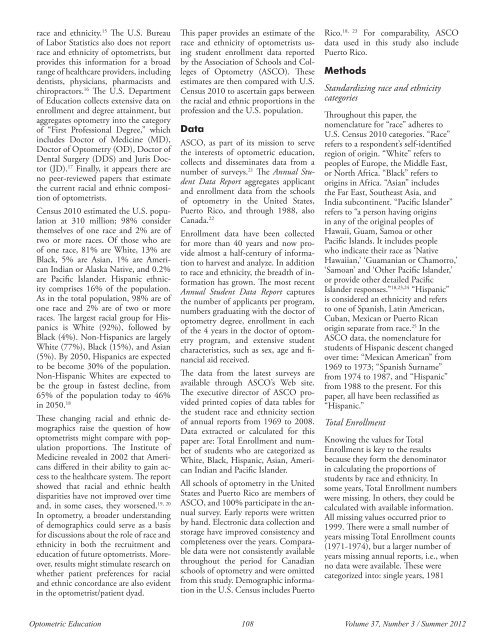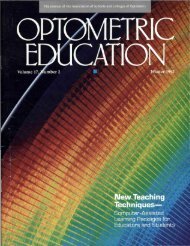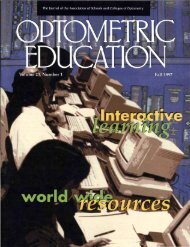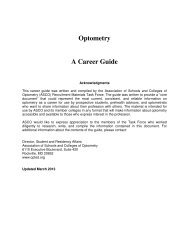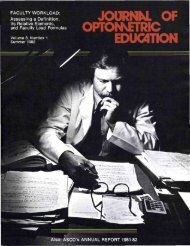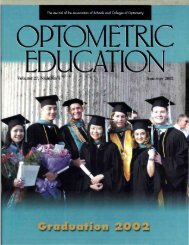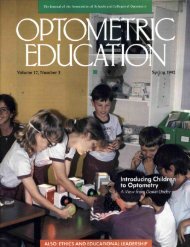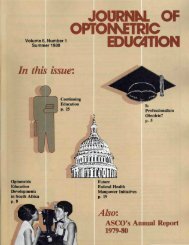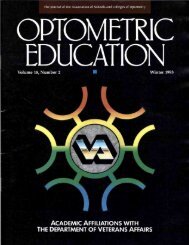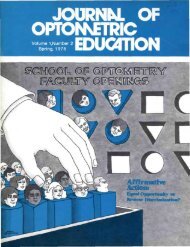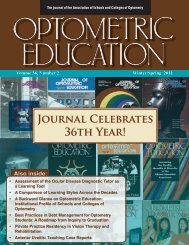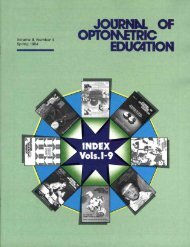Summer 2012, Volume 37, Number 3 - Association of Schools and ...
Summer 2012, Volume 37, Number 3 - Association of Schools and ...
Summer 2012, Volume 37, Number 3 - Association of Schools and ...
You also want an ePaper? Increase the reach of your titles
YUMPU automatically turns print PDFs into web optimized ePapers that Google loves.
ace <strong>and</strong> ethnicity. 15 The U.S. Bureau<br />
<strong>of</strong> Labor Statistics also does not report<br />
race <strong>and</strong> ethnicity <strong>of</strong> optometrists, but<br />
provides this information for a broad<br />
range <strong>of</strong> healthcare providers, including<br />
dentists, physicians, pharmacists <strong>and</strong><br />
chiropractors. 16 The U.S. Department<br />
<strong>of</strong> Education collects extensive data on<br />
enrollment <strong>and</strong> degree attainment, but<br />
aggregates optometry into the category<br />
<strong>of</strong> “First Pr<strong>of</strong>essional Degree,” which<br />
includes Doctor <strong>of</strong> Medicine (MD),<br />
Doctor <strong>of</strong> Optometry (OD), Doctor <strong>of</strong><br />
Dental Surgery (DDS) <strong>and</strong> Juris Doctor<br />
(JD). 17 Finally, it appears there are<br />
no peer-reviewed papers that estimate<br />
the current racial <strong>and</strong> ethnic composition<br />
<strong>of</strong> optometrists.<br />
Census 2010 estimated the U.S. population<br />
at 310 million; 98% consider<br />
themselves <strong>of</strong> one race <strong>and</strong> 2% are <strong>of</strong><br />
two or more races. Of those who are<br />
<strong>of</strong> one race, 81% are White, 13% are<br />
Black, 5% are Asian, 1% are American<br />
Indian or Alaska Native, <strong>and</strong> 0.2%<br />
are Pacific Isl<strong>and</strong>er. Hispanic ethnicity<br />
comprises 16% <strong>of</strong> the population.<br />
As in the total population, 98% are <strong>of</strong><br />
one race <strong>and</strong> 2% are <strong>of</strong> two or more<br />
races. The largest racial group for Hispanics<br />
is White (92%), followed by<br />
Black (4%). Non-Hispanics are largely<br />
White (77%), Black (15%), <strong>and</strong> Asian<br />
(5%). By 2050, Hispanics are expected<br />
to be become 30% <strong>of</strong> the population.<br />
Non-Hispanic Whites are expected to<br />
be the group in fastest decline, from<br />
65% <strong>of</strong> the population today to 46%<br />
in 2050. 18<br />
These changing racial <strong>and</strong> ethnic demographics<br />
raise the question <strong>of</strong> how<br />
optometrists might compare with population<br />
proportions. The Institute <strong>of</strong><br />
Medicine revealed in 2002 that Americans<br />
differed in their ability to gain access<br />
to the healthcare system. The report<br />
showed that racial <strong>and</strong> ethnic health<br />
disparities have not improved over time<br />
19, 20<br />
<strong>and</strong>, in some cases, they worsened.<br />
In optometry, a broader underst<strong>and</strong>ing<br />
<strong>of</strong> demographics could serve as a basis<br />
for discussions about the role <strong>of</strong> race <strong>and</strong><br />
ethnicity in both the recruitment <strong>and</strong><br />
education <strong>of</strong> future optometrists. Moreover,<br />
results might stimulate research on<br />
whether patient preferences for racial<br />
<strong>and</strong> ethnic concordance are also evident<br />
in the optometrist/patient dyad.<br />
This paper provides an estimate <strong>of</strong> the<br />
race <strong>and</strong> ethnicity <strong>of</strong> optometrists using<br />
student enrollment data reported<br />
by the <strong>Association</strong> <strong>of</strong> <strong>Schools</strong> <strong>and</strong> Colleges<br />
<strong>of</strong> Optometry (ASCO). These<br />
estimates are then compared with U.S.<br />
Census 2010 to ascertain gaps between<br />
the racial <strong>and</strong> ethnic proportions in the<br />
pr<strong>of</strong>ession <strong>and</strong> the U.S. population.<br />
Data<br />
ASCO, as part <strong>of</strong> its mission to serve<br />
the interests <strong>of</strong> optometric education,<br />
collects <strong>and</strong> disseminates data from a<br />
number <strong>of</strong> surveys. 21 The Annual Student<br />
Data Report aggregates applicant<br />
<strong>and</strong> enrollment data from the schools<br />
<strong>of</strong> optometry in the United States,<br />
Puerto Rico, <strong>and</strong> through 1988, also<br />
Canada. 22<br />
Enrollment data have been collected<br />
for more than 40 years <strong>and</strong> now provide<br />
almost a half-century <strong>of</strong> information<br />
to harvest <strong>and</strong> analyze. In addition<br />
to race <strong>and</strong> ethnicity, the breadth <strong>of</strong> information<br />
has grown. The most recent<br />
Annual Student Data Report captures<br />
the number <strong>of</strong> applicants per program,<br />
numbers graduating with the doctor <strong>of</strong><br />
optometry degree, enrollment in each<br />
<strong>of</strong> the 4 years in the doctor <strong>of</strong> optometry<br />
program, <strong>and</strong> extensive student<br />
characteristics, such as sex, age <strong>and</strong> financial<br />
aid received.<br />
The data from the latest surveys are<br />
available through ASCO’s Web site.<br />
The executive director <strong>of</strong> ASCO provided<br />
printed copies <strong>of</strong> data tables for<br />
the student race <strong>and</strong> ethnicity section<br />
<strong>of</strong> annual reports from 1969 to 2008.<br />
Data extracted or calculated for this<br />
paper are: Total Enrollment <strong>and</strong> number<br />
<strong>of</strong> students who are categorized as<br />
White, Black, Hispanic, Asian, American<br />
Indian <strong>and</strong> Pacific Isl<strong>and</strong>er.<br />
All schools <strong>of</strong> optometry in the United<br />
States <strong>and</strong> Puerto Rico are members <strong>of</strong><br />
ASCO, <strong>and</strong> 100% participate in the annual<br />
survey. Early reports were written<br />
by h<strong>and</strong>. Electronic data collection <strong>and</strong><br />
storage have improved consistency <strong>and</strong><br />
completeness over the years. Comparable<br />
data were not consistently available<br />
throughout the period for Canadian<br />
schools <strong>of</strong> optometry <strong>and</strong> were omitted<br />
from this study. Demographic information<br />
in the U.S. Census includes Puerto<br />
Rico. 18, 23 For comparability, ASCO<br />
data used in this study also include<br />
Puerto Rico.<br />
Methods<br />
St<strong>and</strong>ardizing race <strong>and</strong> ethnicity<br />
categories<br />
Throughout this paper, the<br />
nomenclature for “race” adheres to<br />
U.S. Census 2010 categories. “Race”<br />
refers to a respondent’s self-identified<br />
region <strong>of</strong> origin. “White” refers to<br />
peoples <strong>of</strong> Europe, the Middle East,<br />
or North Africa. “Black” refers to<br />
origins in Africa. “Asian” includes<br />
the Far East, Southeast Asia, <strong>and</strong><br />
India subcontinent. “Pacific Isl<strong>and</strong>er”<br />
refers to “a person having origins<br />
in any <strong>of</strong> the original peoples <strong>of</strong><br />
Hawaii, Guam, Samoa or other<br />
Pacific Isl<strong>and</strong>s. It includes people<br />
who indicate their race as ‘Native<br />
Hawaiian,’ ‘Guamanian or Chamorro,’<br />
‘Samoan’ <strong>and</strong> ‘Other Pacific Isl<strong>and</strong>er,’<br />
or provide other detailed Pacific<br />
Isl<strong>and</strong>er responses.” 18,23,24 “Hispanic”<br />
is considered an ethnicity <strong>and</strong> refers<br />
to one <strong>of</strong> Spanish, Latin American,<br />
Cuban, Mexican or Puerto Rican<br />
origin separate from race. 25 In the<br />
ASCO data, the nomenclature for<br />
students <strong>of</strong> Hispanic descent changed<br />
over time: “Mexican American” from<br />
1969 to 1973; “Spanish Surname”<br />
from 1974 to 1987, <strong>and</strong> “Hispanic”<br />
from 1988 to the present. For this<br />
paper, all have been reclassified as<br />
“Hispanic.”<br />
Total Enrollment<br />
Knowing the values for Total<br />
Enrollment is key to the results<br />
because they form the denominator<br />
in calculating the proportions <strong>of</strong><br />
students by race <strong>and</strong> ethnicity. In<br />
some years, Total Enrollment numbers<br />
were missing. In others, they could be<br />
calculated with available information.<br />
All missing values occurred prior to<br />
1999. There were a small number <strong>of</strong><br />
years missing Total Enrollment counts<br />
(1971-1974), but a larger number <strong>of</strong><br />
years missing annual reports, i.e., when<br />
no data were available. These were<br />
categorized into: single years, 1981<br />
Optometric Education 108 <strong>Volume</strong> <strong>37</strong>, <strong>Number</strong> 3 / <strong>Summer</strong> <strong>2012</strong>


